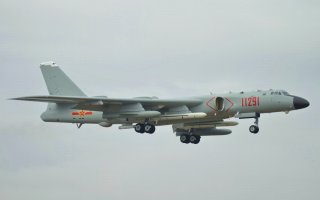Watch Out: China Has a New Bomber-Launched Anti-Ship Missile
Meet the CH-AS-X-13.
Key Point: The CH-AS-X-13 could pose a serious threat to U.S. and allied forces.
A Chinese magazine might have revealed a new and potentially powerful anti-ship and land-attack missile, Roland Oliphant reported for The Telegraph last year.
A centerfold graphic in a recent issue of Modern Ships, a government-produced magazine, depicts the Chinese air force’s new H-6N bomber carrying a previously unknown large missile under its belly, according to Oliphant.
The computer-generated image could represent the public’s first glimpse of the CH-AS-X-13, an air-launched variant of the DF-21D anti-ship ballistic missile.
The Chinese air force has modified a small number of H-6s apparently to carry the new missile, which could pose a serious danger to U.S. Navy vessels and other forces operating in the western Pacific. Aircraft carriers, in particular, could be at risk.
The new H-6N variant of the venerable Chinese bomber first appeared over Beijing during preparations for celebrations marking the 70th anniversary of the founding of the People’s Republic of China. Military parades and fly-overs took place on Oct. 1, 2019.
The H-6Ns feature an under-fuselage recess that could accommodate a single, very large missile. The DF-21D is more than 30 feet long and weighs around 32,000 pounds. It can travel as far as 1,300 miles with a 1,200-pound warhead.
“Experts say that there at least four of these aircraft presently assigned to a People's Liberation Army Air Force bomber brigade in China's Central Theater Command region,” Joseph Trevithick wrote at The War Zone.
Reports about the H-6N and its ballistic-missile launching mission first began to emerge in 2017. Xi'an Aircraft International Corporation's H-6, a derivative of the Soviet-era Tu-16 Badger, has been the centerpiece of China's bomber force since the 1970s.
In 2009, the H-6K variant, a significant redesign from the original aircraft optimized as a carrier for long-range anti-ship and land-attack cruise missiles, entered service. The H-6N is a further outgrowth of this earlier missile carrier version.
The most notable change between the N and K is the complete elimination of the bomb bay on the N and the addition of semi-recessed area with a hard point for a large missile. This is similar in some general respects to the ability of Russia's Tu-22M Backfire bombers can carry a single Kh-22 or Kh-32 anti-ship cruise missile in a semi-recessed mount under its central fuselage.
There are no pictures from the parade preparations that show the H-6Ns carrying a payload and some of them appear to have a plug installed that gives the fuselage its normal profile when a missile is not loaded. So, it remains unclear what type of weapon, or weapons, the Chinese intend to employ on these aircraft.
But Trevithick thinks it’s the CH-AS-X-13, which apparently is “the primary weapon for the H-6N.” The Hong Kong South China Morning Post claimed the H-6N also is designed to carry the new DF-100 anti-ship cruise missile and the DR-8 supersonic reconnaissance drone.
The DR-8 appeared on a trailer during a rehearsal for the October 2019 anniversary celebration. The drone in theory could conduct fast damage-assessment missions in the aftermath of missile strikes. “The DR-8 would be expected to play a key role should there be a conflict with U.S. aircraft carrier strike groups in the South China Sea or Western Pacific,” South China Morning Post reported.
H-6Ns with CH-AS-X-13s could pose a serious threat to U.S. and allied forces, Malcolm Davis, a senior analyst with the Australian Strategic Policy Institute, told Oliphant. "The combination of the range of that system -- [more than 1,000 miles] plus the range of the H-6N -- would give China greater ability to strike either at land targets as far out as Guam, or potentially, if equipped with an anti-ship mode, maritime targets at similar range.”
But Global Times, China's state-owned English-language daily, sidestepped questions regarding the H-6N and its possible new missile. The daily dismissed Modern Ships’s centerfold as fantasy. "The images are computer-generated, merely conceptual and have no official background," Global Times stated, citing an "insider" source.
David Axe served as Defense Editor of the National Interest. He is the author of the graphic novels War Fix, War Is Boring and Machete Squad. This first appeared in 2019 and is being reposted due to reader influence.
Image: Wikimedia Commons

